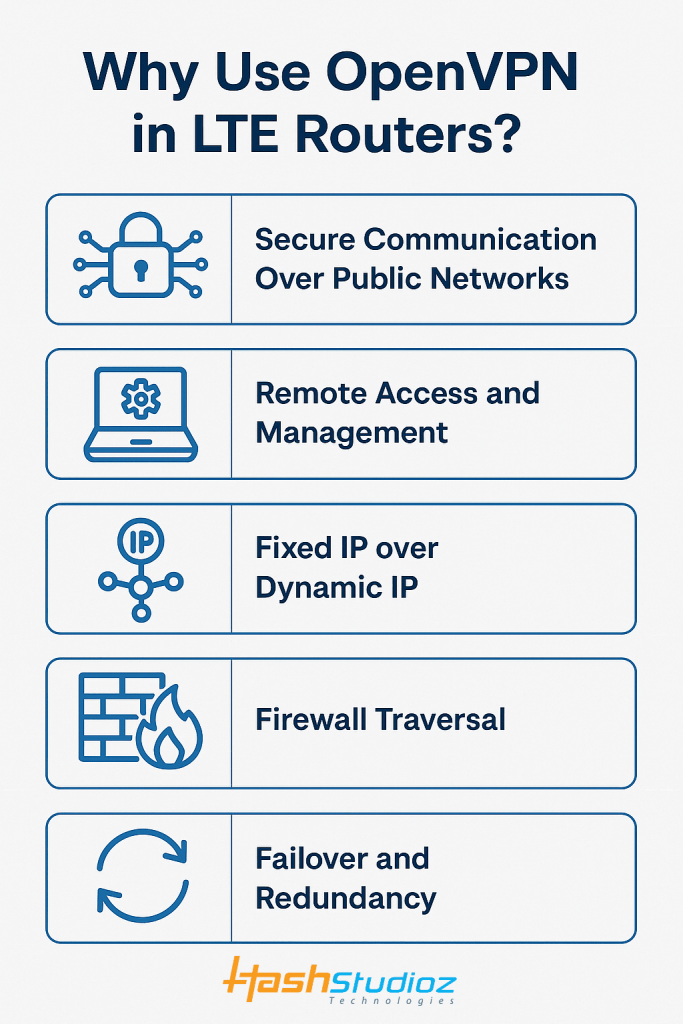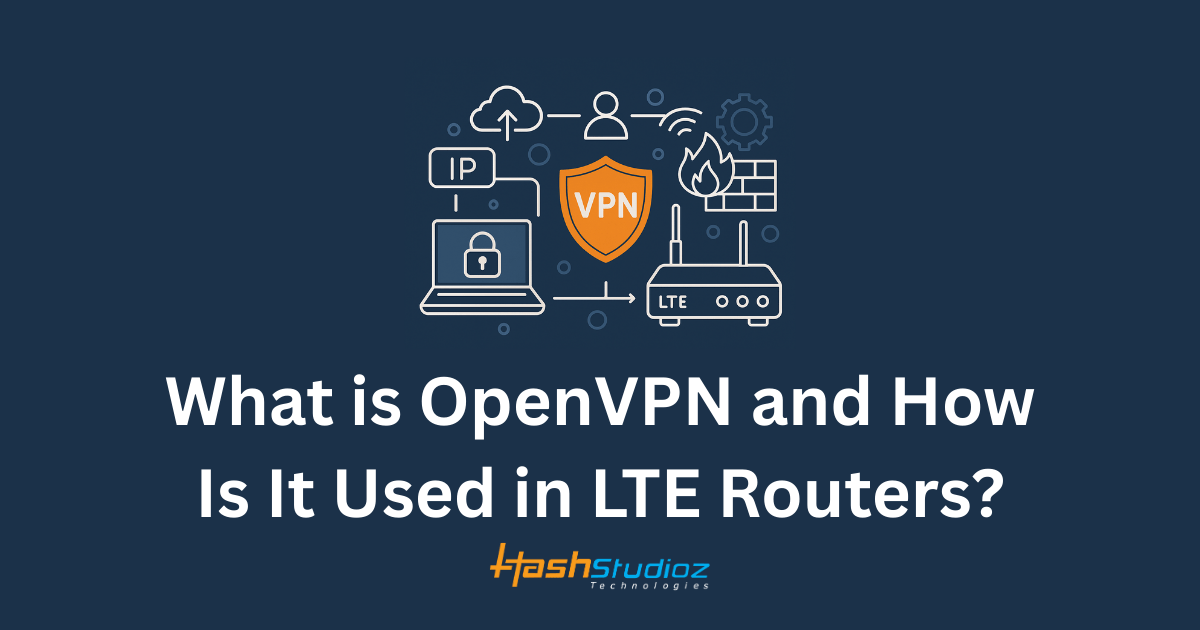As internet connectivity extends beyond traditional broadband to include mobile-based solutions like LTE routers, security and privacy have become paramount. One critical technology that helps ensure secure communication over public or untrusted networks is OpenVPN. In this blog, we’ll explore OpenVPN from a technical standpoint and understand how it integrates with LTE routers to provide secure, scalable, and remote network access.
Table of Contents
What is OpenVPN?
OpenVPN is an open-source Virtual Private Network (VPN) solution that enables secure point-to-point or site-to-site connections in routed or bridged configurations. It uses a custom security protocol that leverages:
- SSL/TLS for key exchange
- AES (Advanced Encryption Standard) for data encryption
- HMAC for message integrity
- OpenSSL for cryptographic functions
Originally released in 2001, OpenVPN has gained popularity due to its flexibility, reliability, and compatibility with various platforms including Linux, Windows, macOS, iOS, Android, and embedded systems.
Core Components of OpenVPN
- OpenVPN Server: Acts as the central hub that client devices (including LTE routers) connect to. The server handles authentication, encryption, and routing.
- OpenVPN Client: Installed on the device initiating the VPN connection. In the case of LTE routers, the firmware often includes a built-in OpenVPN client.
- Configuration Files (.ovpn): These contain connection details, encryption keys, server IP/domain, and other parameters essential for establishing a VPN tunnel.
- Encryption and Authentication
- Symmetric encryption (e.g., AES-256) secures data packets.
- TLS handles key exchange and certificate-based authentication.
- HMAC (Hash-based Message Authentication Code) validates data integrity.
- Symmetric encryption (e.g., AES-256) secures data packets.
What Are LTE Routers?
LTE routers are networking devices that provide internet connectivity through LTE (Long-Term Evolution) cellular networks. They contain a SIM card and cellular modem to connect to 4G networks, converting this into a local Wi-Fi or Ethernet connection for end-user devices.
Key Characteristics of LTE Routers:
- Support for mobile broadband (3G/4G/5G)
- Dual SIM failover for reliability
- Remote management capabilities
- Often used in IoT, industrial, mobile, and rural environments
Why Use OpenVPN in LTE Routers?

Using LTE routers in enterprise or mission-critical deployments often requires secure, encrypted communication between remote sites and central servers. Here’s where OpenVPN proves invaluable:
1. Secure Communication Over Public Networks
LTE routers often operate over public mobile networks. OpenVPN provides an encrypted tunnel between the LTE router and a private server, ensuring that data transmitted over the cellular network remains confidential.
2. Remote Access and Management
OpenVPN allows IT administrators to remotely access LTE routers and connected devices securely, facilitating monitoring, troubleshooting, and updates.
3. Fixed IP over Dynamic IP
Most LTE networks provide dynamic public IPs, which complicates routing and access. With OpenVPN, a static private IP can be assigned within the VPN, creating a stable addressing environment.
4. Firewall Traversal
OpenVPN uses UDP or TCP ports (commonly UDP 1194) and can be configured to mimic HTTPS traffic (TCP 443), allowing it to bypass NATs and firewalls.
5. Failover and Redundancy
In dual-SIM LTE routers, OpenVPN connections can be configured to automatically reconnect if the primary cellular provider fails ensuring high availability.
How OpenVPN Works in LTE Routers (Step-by-Step)
Let’s break down how an OpenVPN connection is established and used in an LTE router environment:
1. Router Initialization
Once powered on, the LTE router connects to the cellular network using its internal modem and SIM card.
2. VPN Client Configuration
The router’s firmware includes an OpenVPN client. It reads a .ovpn file or a set of parameters configured via its web interface or command line.
3. TLS Handshake
The client initiates a handshake with the OpenVPN server using SSL/TLS, authenticating both parties using certificates or pre-shared keys.
4. Tunnel Establishment
Once authenticated, a secure tunnel is created using AES encryption. Traffic from the LTE router (and connected LAN devices) is routed through this tunnel.
5. Data Transmission
All packets are encapsulated in the VPN tunnel, preventing third-party interception or tampering.
6. Remote Access or Data Sync
The router can now communicate with internal systems (e.g., SCADA, ERP, CCTV servers) at the central site, or administrators can manage the router remotely.
Use Cases of OpenVPN in LTE Router Deployments
1. Industrial IoT Gateways
Machines in factories or remote oil rigs connected via LTE routers can securely send data to cloud servers using OpenVPN tunnels.
2. Retail or ATM Networks
POS terminals or ATMs use LTE routers with VPN tunnels to connect to banking systems securely.
3. Surveillance and Smart Cities
CCTV cameras and sensors in public infrastructure can stream encrypted data back to control centers.
4. Vehicle Telematics
Fleet management systems use LTE routers in vehicles to securely transmit GPS and diagnostics to central databases.
Challenges and Considerations
1. Certificate Management: OpenVPN relies heavily on X.509 certificates. Managing and rotating these in large-scale LTE deployments requires automation.
2. Bandwidth Overhead: VPN tunnels introduce encryption overhead, slightly reducing effective LTE bandwidth.
3. Power Consumption: LTE routers with active VPN connections may consume more power, which is a consideration for solar-powered or battery-backed systems.
4. Dynamic IP Handling: Since LTE networks often use CGNAT (Carrier-Grade NAT), the OpenVPN server must be reachable via a public IP or DNS hostname.
Conclusion
OpenVPN is a robust and versatile VPN solution that significantly enhances the security of LTE router deployments. By creating encrypted tunnels between remote routers and central systems, it enables secure access, remote management, and stable communication across public cellular networks. Whether you’re deploying IoT systems, managing remote infrastructure, or building secure mobile networks, integrating OpenVPN with LTE routers is a best practice that balances security, flexibility, and performance.
Partner with a Trusted IoT Development Company
Want to build a secure, connected system using LTE routers and OpenVPN?
HashStudioz Technologies is an expert IoT development company that helps businesses design smart, secure solutions for everything from industrial automation to smart cities.
👉 Get in touch with us today to discuss how we can help secure your IoT systems and LTE-based networks!

